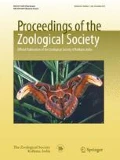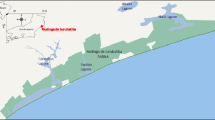Abstract
An extracellular polymeric substance (EPS) producing microorganism, identified and characterized as Bacillus licheniformis strain KX657843 based on 16S rRNA sequencing and phylogenetic analysis, was isolated from earthworms (Metaphire posthuma). The bacteria was found to be uniquely influenced by the amino acid l-asparagine monohydrate. The organism produced the maximum yield of 2.7 g L−1 EPS in the presence of sucrose supplemented with l-asparagine monohydrate while no EPS was produced in absence of the amino acid. The order of growth and EPS production in presence of different carbon substrates supplemented with l-asparagine monohydrate was observed as sucrose > glucose > glycerol > mannitol > citrate > cellulose > starch. l-asparagine monohydrate could serve as the sole nitrogen source for the organism but it alone cannot satisfy the requisite carbon demand for growth and EPS production. EPS production showed a positive correlation with sucrose concentration but a negative correlation with citrate levels. Analysis of extracted EPS using Fourier transform infrared spectroscopy and measurement of its zeta potential revealed the chemical composition and anionic nature of the EPS. The bacterium produced 119.235 IU mL−1 extracellular l-asparaginase. This is the first report of an l-asparagine monohydrate dependent EPS producing Bacillus licheniformis from the gut of the earthworm, Metaphire posthuma.







Similar content being viewed by others
References
Ahmad, A.Z., V.K. Poulsen, T. Janzen, P. Buldo, P.M.F. Derkx, G. Oregaard, and A.R. Neves. 2017. Polysaccharide production by lactic acid bacteria: From genes to industrial and applications. FEMS Microbiology Reviews 41: 168–200.
Antonio, S., G. Concetta, L. Valeria, L.M. Teresa, A. Gianluca, P. Annarita, and N. Barbara. 2013. A novel EPS-producing strain of Bacillus licheniformis Isolated from a shallow vent off Panarea island (Italy). Current Microbiology 67: 27–29.
Ali, U., N. Sajid, A. Khalid, L. Riaz, M. Rabbani, J.H. Syed, and R.N. Malik. 2015. A review on vermicomposting of organic wastes. Environmental Progress and Sustainable Energy 34: 1050–1062.
Batool, R., K. Yrjala, and S. Hasnain. 2014. Impact of environmental stress on biochemical parameters of bacteria reducing chromium. Brazilian Journal of Microbiology 45: 573–583.
Batool, R., K. Yrjala, K. Shaukat, N. Jamil, and S. Hasnain. 2015. Production of EPS under Cr(VI) challenge in two indigenous bacteria isolated from a tannery effluent. Journal of Basic Microbiology 55: 1064–1074.
Benson, H.J. 2015. Microbiological application laboratory manual in general microbiology. New York: McGraw Hill Education.
Bhat, S.A., J. Singh, and A. Pal. 2017. Earthworms as organic waste managers and biofertilizer producers. Waste Biomass valor. https://doi.org/10.1007/s12649-017-9899-8.
Biswas, J.K., M. Mondal, J. Rinklebe, S.K. Sarkar, P. Chaudhuri, M. Rai, S.M. Shaheen, H. Song, and M. Rizwan. 2017. Multi-metal resistance and plant growth promotion potential of a wastewater bacteria and its synergistic benefits. Environmental Geochemistry and Health. https://doi.org/10.1007/s10653-017-9950-5.
Busi, S., S. Karuganti, J. Rajkumari, P. Paramanandham, and S. Pattnaik. 2017. Sludge settling and algal flocculation activity of extracellular polymeric substance (EPS) derived from Bacillus cereus SK. Water and Environment Journal 31: 97–104.
Byzov, B.A., V.V. Tikhonov, T.Y. Nechitailo, and V.V. Demin. 2015. Taxonomic composition and physiological and biochemical properties of bacteria in the digestive tracts of earthworms. Eurasian Journal of Soil Science 48: 268–275.
Cérantola, S., J.D. Bounéry, C. Segonds, and N. Marty. 2000. Exopolysaccharide production by mucoid and non mucoid strains of Burkholderia cepacia. FEMS Microbiology Letters 185: 243–246.
Davey, M.E., and G.A. O’Toole. 2000. Microbial biofilms: from ecology to molecular genetics. Microbiology and Molecular Biology Reviews 64: 847–867.
Drake, H.L., and M.A. Horn. 2007. As the worm turns: the earthworm gut as a transient habitat for soil microbial biomes. Annual Review of Microbiology 61: 169–189.
Dubois, M., K.A. Gilles, J.K. Hamilton, P.A. Rebers, and F. Smith. 1956. Colorimetric method for determination of sugars and related substances. Analytical Chemistry 28: 350–356.
Grobben, G.J., I. Chin-Joe, and V.A. Kitzen. 1998. Enhancement of exopolysaccharide production by Lactobacillus delbrueckii subsp. bulgaricus NCFB 2772 with a simplified defined medium. Applied and Environmental Microbiology 64: 1333–1337.
Harutoshi, T. 2013. Exoplysaccharides of lactic acid bacteria for food and colon health applications. In Lactic acid bacteria- R & D for food and livestock purpose, ed. M. Kongo, 515–538. Croatia: Intech.
Hussain, N., A. Singh, S. Saha, M.V.S. Kumar, P. Bhattacharya, and S.S. Bhattacharya. 2016. Excellent N-fixing and P- solubizing traits in earthworm gut isolated bacteria: A vermicompost based assessment with vegetable market waste and rice straw feed mixtures. Bioresource Technology 222: 165–174.
Horn, M.A., A. Schramm, and H.L. Drake. 2003. The earthworm gut: an ideal habitat for ingested N2O-producing microorganisms. Applied and Environmental Microbiology 69: 1662–1669.
Hunter, R.J. 1981. Zeta Potential in Colloids Science. New York: Academic Press.
Kale, R.D., and N. Karmegam. 2010. The role of earthworms in tropics with emphasis on Indian ecosystems. Applied and Environmental Soil Science. https://doi.org/10.1155/2010/414356.
Khani, M., N. Bahrami, A. Chegeni, M.D. Ghafari, and A.M. Zadeh. 2016. Optimization of carbon and nitrogen sources for extracellular polymeric substances production by Chryseobacterium indologenes MUT.2. Iranian Journal of Biotechnology 14: 13–18.
Kumari, B.S., M. Raghu Ram, and K.V. Mallaiah. 2009. Studies on exopolysaccharide and indole acetic acid production by Rhizobium strains from Indigofera. African Journal of Microbiology Research 3: 10–14.
Kuntiya, A., P. Hanmoungjai, and C. Techapun. 2010. Influence of pH, sucrose concentration and agitation speed on exopolysaccharide production by Lactobacillus confuses TISTR 1498 using coconut water as a raw material substitute. Maejo International Journal of Science and Technology 4: 318–330.
Liu, D.B., CWu Lian, and P.A. Guo. 2017a. Comparative study of gut microbiota profiles of earthworms fed in three different substrates. Symbiosis. https://doi.org/10.1007/s13199-017-0491-6.
Liu, J., X. Chi, W. Huimin, P. Shuang, J. Liu, and K. Changai. 2017b. Recent advances in endophytic exopolysaccharides: Production, structural characterization, physiological role and biological activity. Carbohydrate Polymers 157: 1113–1124.
Looijesteijn, P.N., I.C. Boels, M. KleeRrebezem, and J. Hugenholtz. 1999. Regulation of exopolysaccharide production by Lactococcus lactis subsp. cemoris by the sugar source. Applied and Environmental Microbiology 65: 5003–5008.
Lowry, S. 1951. Determinants of extracellular protein secretion in Gram-negative bacteria. Journal of Bacteriology 174: 3423–3428.
Marini, B.L., A.J. Perissinotti, D.L. Bixby, J. Brown, and P.W. Burke. 2017. Catalyzing improvements in ALL therapy with asparaginase. Blood Reviews 31: 328–338.
Mashburn, L., and J. Wriston. 1963. Tumor inhibitory effect of l-Asparaginase. Biochemical and Biophysical Research Communications 2: 50–55.
Natalia, A.C., L.V. Alejandra, and I.F. Julia. 2017. Biopolymer of microbial origin. In Advances in physiochemical properties of biopolymers, ed. M. Masuelli and D. Renard, 109–193. Sharjah, U.A.E.: Bentham Science Publishers.
Nouha, K., S.R. Kumar, S. Balasubhramanian, and R.D. Tyagi. 2017. Critical review of EPS production, synthesis and composition for sludge flocculation. Journal of Environmental Sciences. https://doi.org/10.1016/j.jes.2017.05.020.
Osadchaya, A.I., V.A. Kudryavtsev, and I.A. Kozachko. 1997. Nitrogen nutrition of strains of aerobic spore-forming bacteria under conditions of submerged cultivation. Prikladnaia Biokhimiia i Mikrobiologiia 33: 433–438.
Palmer, J., S. Flint, and J. Brooks. 2007. Bacterial cell attachment, the beginning of a biofilm. Journal of Industrial Microbiology and Biotechnology 34: 577–588.
Pathma, J., and N. Sakthivel. 2012. Microbial diversity of vermicompost bacteria that exhibit useful agricultural traits and waste management potential. Springer Plus. https://doi.org/10.1186/2193-1801-1-26.
Pawar, S.T., A.A. Bhosale, B.T. Gawade, and R.T. Nale. 2013. Isolation, screening and optimization of exopolysaccharide producing bacterium from saline soil. Journal of Microbiology and Biotechnology Research 3: 24–31.
Punch, J.D., J.C. Olson, and J.V. Scaletti. 1965. Amino acid utilization by Alcaligenes viscolactis for growth and slime production. Journal of Bacteriology 89: 1521–1525.
Rao, B.P., K. Sudharsan, C.H. Reshma, G. Sekharan, and A.B. Mandal. 2013. Characterization of exopolysaccharide from Bacillus amyloliquefaciens BPRGS for its bioflocculant activity. International Journal of Scientific and Engineering Research 4: 1696–1704.
Singh, R., D. Paul, and R.K. Jain. 2006. Biofilms: Implications in bioremediation. Trends in Microbiology 14: 389–397.
Singleton, D.R., P.F. Hendrix, D.C. Coleman, and W.B. Whitman. 2003. Identification of uncultured bacteria tightly associated with the intestine of the earthworm Lumbricus rubellus (Lumbricidae; Oligochaeta). Soil Biology & Biochemistry 35: 1547–1555.
Sirajunnisa, A.R., V. Vijayagopal, and T. Viruthagiri. 2013. Medium optimization for the production of exopolysaccharide by Bacillus subtilis using synthetic sources and agro wastes. Turkish Journal of Biology 37: 280–288.
Sleytr, U.B. 1997. Basic and applied S-layer research: an overview. FEMS Microbiology Letters 20: 5–12.
Sunil, T.P., A.B. Amarsinh, B.G. Trishala, and R.N. Tejswini. 2013. Isolation, screening and optimization of exopolysaccharide producing bacterium from saline soil. Journal of Microbiology and Biotechnology Research 3: 24–31.
Sutherland, I.W. 2001. Microbial polysaccharides from Gram-negative bacteria. International Dairy Journal 11: 663–674.
Tamura, K., G. Stecher, D. Peterson, A. Filipski, and S. Kumar. 2013. MEGA6: molecular evolutionary genetics analysis version 6.0. Molecular Biology and Evolution 30: 2725–2729.
Tsuneda, S., H. Aikawa, H. Hayashi, A. Yuasa, and A. Hirata. 2003. Extracellular polymeric substances responsible for bacterial adhesion onto solid surface. FEMS Microbiology Letters 223: 287–292.
Yuanyuan, C., W. Xing, C. Peng, H. Qiaoyun, R. Xinming, and L. Wei. 2011. Preferential adsorption of extracellular polymeric substances from bacteria on clay minerals and iron oxide. Colloids and Surfaces B: Biointerfaces 83: 122–127.
Zhang, T., C. Zhang, and S. Li. 2011. Growth and exopolysaccharide production by Streptococcus thermophilus ST1 in skim milk. Brazilian Journal of Microbiology 42: 1470–1478.
Acknowledgements
The study was financially supported by Department of Science and Technology (DST), Government of India in the form of providing INSPIRE Fellowship (Code No.: 1F131101) to Anurupa Banerjee for carrying out research work under the supervision of Dr. Jayanta Kumar Biswas. The Authors duly acknowledge the infrastructural support provided by Department of Ecological Studies, University of Kalyani as well as the facility available under the DST-PURSE programme. SM is thankful to the Fulbright-Nehru Post-Doctoral Fellowship Programme (Award No. 2203/FNPDR/2016) from the United States-India Educational Foundation (USIEF). Professor Mary Beth Kirkham, Department of Agronomy, Kansas State University Manhattan, USA made constructive comments on the manuscript and rendered help with its English composition. Authors express their gratitude to Dr. Amit Chowdhury, an earthworm expert for his help in identifying the earthworm species. Authors are also thankful to Mr. Prabuddha Sur, Department of Chemistry, University of Kalyani for helping in the FTIR analysis.
Author information
Authors and Affiliations
Corresponding author
Ethics declarations
Conflict of interest
The authors have no financial/commercial conflicts of interest.
Rights and permissions
About this article
Cite this article
Biswas, J.K., Banerjee, A., Majumder, S. et al. New Extracellular Polymeric Substance Producing Enteric Bacterium from Earthworm, Metaphire posthuma: Modulation Through Culture Conditions. Proc Zool Soc 72, 160–170 (2019). https://doi.org/10.1007/s12595-017-0250-y
Received:
Revised:
Accepted:
Published:
Issue Date:
DOI: https://doi.org/10.1007/s12595-017-0250-y




